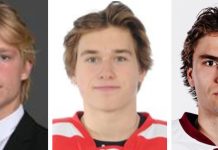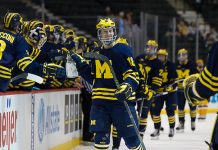The action is starting to pick up in the Hobey Watch with conference playoffs under way in the CCHA, Atlantic Hockey and ECAC Hockey. Of course, the announcement of the top 10 finalists for the Hobey Baker Award takes place prior to the conference championship weekend, so the next two weeks will offer Hobey hopefuls one last opportunity to state their case for inclusion in the top 10.
One such individual who’s hitting the ice this weekend is Greg Carey of St. Lawrence, although I think it’s fair to say that he’s made as much of a case for the top 10 as he needs to. A goal in Game 1 of a best-of-three ECAC Hockey first-round playoff series against Colgate on Friday gave him 27 for the season (four more than his closest competitor), and he’s second nationally in points per game, with only Ryan Walters of Nebraska-Omaha ahead of him. Based on those numbers alone, Carey is a shoo-in for a spot in the top 10, and could contend for a place in the Hobey Hat Trick. With that in mind, I talked to the coach of another team in the conference this week to get his take on the junior from Hamilton, Ontario.
“He scores goals,” the coach said. “He can just plain bring it and score. He seems to do it game in and game out, so he’s very consistent. He’s impressive. In terms of being able to do it night in and night out, he just seems to score. Just an outstanding player.”
Really, there are only two big knocks I can see on Carey’s candidacy. While he is indeed the national leader in goals, 13 of his 27 have come on the power play. Given that some observers tend to knock players who clean up on the power play a bit (at least, compared to players who do more of their damage at even strength), that might be a factor working against Carey in the final round of voting, when the Hobey winner and the two other members of the Hobey Hat Trick are chosen. However, the coach doesn’t see it that way.
“He’s a threat no matter what,” the coach said. “In today’s day and age it’s not easy to score on the power play. People defend and block pucks, and the goaltending’s very, very good. To have that quick release and anticipation and that ability to get the puck off quickly and find those seams to get pucks to the net, that’s a pretty good skill. I wouldn’t discount him for the power-play goals because it’s not easy to score on the power play nowadays.”
Personally, I tend to agree, and given how important special teams are, I would think that being able to consistently deliver with the man advantage would be a positive in the Hobey race. What’s trickier, however, is that St. Lawrence is a long shot to make the NCAA tournament. After Friday’s games, the Saints are tied for 23rd in the PairWise Rankings, and with so many competitive teams in ECAC Hockey (four in the PairWise top 20) winning the conference tournament is going to be a serious uphill battle. While that won’t preclude Carey from getting into the Hat Trick — remember, the 2010 Hat Trick included two players from non-tournament teams — it will make it distinctly tougher, particularly when players like Johnny Gaudreau, Erik Haula, Drew LeBlanc, Danny Kristo and Corban Knight won’t have that problem.
Carey has big numbers, but so does Walters, and my gut feeling is there’s only room for one non-tournament player in this year’s Hobey Hat Trick. Given that Walters has more points, a healthy goal total and a stronger conference, I think it’s a fairly safe bet as to which way that one goes.
Now, while I had an ECAC coach on the phone, I figured it’d be a good idea to discuss Quinnipiac goaltender Eric Hartzell as well. After all, Hartzell is having an outstanding year, having backstopped the Bobcats to the No. 1 spot in the PairWise and the Cleary Cup as regular-season ECAC champions, and is easily the most Hobey-eligible player on his team.
You may recall that in 2010, Miami goalie Cody Reichard was the RedHawks’ Hobey finalist despite having appeared in only half of his team’s games. Part of the reason was that the RedHawks’ top scorers were too indistinguishable from one another for one to be singled out as a Hobey finalist. When you look at the Bobcats, none of whom has more than 13 goals, it becomes clear that the best representative of the team is its goalie, whose team leads the nation in scoring defense while he himself ranks third in goals against average (1.49, best among full-time starters) and seventh in save percentage (.936). It would be stunning if Hartzell wasn’t one of the top 10.
I asked the coach where Hartzell stands up among other recent Hobey finalist goaltenders out of the ECAC like Zane Kalemba of Princeton, Ben Scrivens of Cornell and Keith Kinkaid and Troy Grosenick from Union.
“His numbers are excellent,” the coach said. “I think he stacks up very favorably with all those guys. He’s in that high-end class because he’s got the size, he’s got that confident way that he plays and he’s very efficient. He’s not flopping all over the place. The puck hits him. He just plays with an air of confidence, and I think the team is so together in terms of defending. Hartzell fits in perfectly with their team, he makes that good first save and they do a good job of keeping rebounds away. I was really impressed with Hartzell, and I’m impressed with the team.”
I think that Hartzell has a much higher upside in the Hobey race than Carey because he has an opportunity to lead the Bobcats to the Frozen Four. If Quinnipiac is still playing when the final vote takes place, I think that it’s very easy to see Hartzell in the Hobey Hat Trick. Beyond that, I’m not sure, given that the Hobey doesn’t go to goalies very easily. It may depend to one degree or another what the people around him do.
What do you think? Leave your thoughts below.


